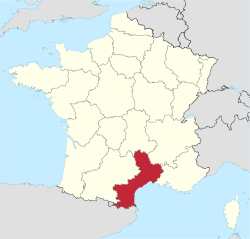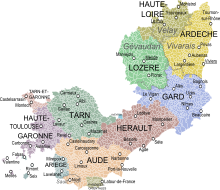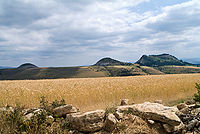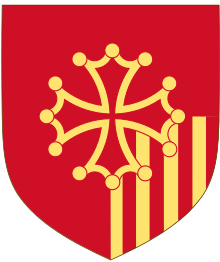Languedoc-Roussillon
Languedoc-Roussillon
Lengadòc-Rosselhon(Occitan) | |
|---|---|
 | |
| Country | |
| Dissolved | 2016-01-01 |
| Prefecture | Montpellier |
| Departments | 5
|
| Government | |
| •President | Damien Alary (DVG) |
| Area | |
| • Total | 27,376 km2(10,570 sq mi) |
| Population (2012-01-01) | |
| • Total | 2,700,266 |
| • Density | 99/km2(260/sq mi) |
| GDP | |
| • Total | €85.916 billion (2022) |
| • Per capita | €30,400 (2022) |
| Time zone | UTC+1(CET) |
| • Summer (DST) | UTC+2(CEST) |
| ISO 3166 code | FR-K |
| NUTS Region | FR8 |
| Website | laregion.fr |
Languedoc-Roussillon(French pronunciation:[lɑ̃ɡ(ə)dɔkʁusijɔ̃];Occitan:Lengadòc-Rosselhon[ˌleŋɡɔˈðɔkruseˈʎu];Catalan:Llenguadoc-Rosselló) is a formeradministrative regionofFrance.On 1 January 2016, it joined with the region ofMidi-Pyrénéesto becomeOccitania.[2]It comprised fivedepartments,and bordered the other French regions ofProvence-Alpes-Côte d'Azur,Rhône-Alpes,Auvergne,Midi-Pyrénéestowards the north, andSpain,Andorraand theMediterranean Seatowards the south. It was the southernmost region of mainland France.
Toponymy
[edit]The first part of the name of the province of Languedoc-Roussillon comes from the Frenchlangue d'oc( "language ofoc"), and is also ahistorical region.In southern France, the word foryeswas theOccitan languagewordoc.Prior to the 16th century, the central area of France was referred to asLanguedoil,there the word foryeswasoilinOld French,later becomingoui.These old place names referred to the areas where Occitan and Old French were spoken.[3]TheEdict of Villers-Cotteretsmade French the official national language in 1539.Roussillonwas the name of the medievalCounty of Roussillon.
History
[edit]

Towards the end of the 3rd century BC, aCeltic people,theVolcae,took up residence in the region between theRhôneand theGaronne,from theCévennesto thePyrenees.[4][5]Their capitals wereToulouse[6]andNîmes.[7]
They made a pact with the Romans from the 1st century BC.Narbonnewas created to pacify the province in 118 BC and became the capital of theNarbonnaise.[8]
At the beginning of the 5th century, theVandalsinvaded the province and then theVisigothssettled there. The Narbonne region, like theIberian Peninsula,remained Visigothic until its conquest by theMoorsbetween 719 (fall of Narbonne)[9]and 725 (fall ofCarcassonneand Nîmes).[10]Narbonne then became the capital of one of the five provinces ofAl-Andalusled by awalifor nearly forty years.[11]
The region was conquered byPépin the Short(fall of Narbonne in 759),[12]who made it themarquisate of Gothia,included in thekingdom of Aquitaine[13]created in 778. This vast territory encompassed all of the south of the Rhône to theAtlanticand was bequeathed byCharlemagneto his sonLouis the Piousin 781.[8]The administration was entrusted to thecounts of Toulouse.
During the feudal era, a great political fragmentation took place: thecounties of RoussillonandCerdanyapassed into the orbit of theCrown of Aragon,[14]while Bas-Languedoc passed under the domination of thehouse of Trencaveland their rivals the counts of Toulouse.[15]
Raymond IV(1042–1115) achieved through marriage the objective of reunification by enlarging his state to thecounty of Rouergue,Nîmes, Narbonne,Gévaudan,Agde,BéziersandUzès.[16]
The fight againstCatharismand theAlbigensian Crusade[17]led to the extinction of the dynasty of the Counts of Toulouse. The province was united to theKingdom of Francein 1271, with the exception ofMontpellier,which remained under the influence of theHouse of Barcelonaand then of Majorca, and which was not attached to the Kingdom of France until 1349. From there was born the royal Languedoc which persisted until theFrench Revolution.
TheTreaty of Corbeil in 1258ratified the division with the southern territories of the region.[18]TheCorbièresformed the border between the Kingdom of France and thePrincipality of Cataloniain the Crown of Aragon.[19]
In 1659, theTreaty of the Pyreneesled to the annexation of Roussillon and northern Cerdanya to the Kingdom of France.[20]
Population
[edit]The region is experiencing the strongest demographic growth in France, and could have around 3,300,000 inhabitants by 2030,[21]an increase of 36% compared to 2000. This increase is mainly due tointernal migration,natural increase being rather low.[22]
Pyrénées-Orientaleshas the largest proportion of elderly people (12.10% over 75).GardandHéraultare the "youngest" departments, but they are destined to "age" considerably in the coming years. By 2020, the number of people aged over 75 is expected to increase by 12% across the region.
Religion
[edit]Catholicismis the most represented religion in the region, particularly at the level of historical monuments and associations.[citation needed]The Ecclesiastical Province of Montpellier (French:Province ecclésiastique de Montpellier) corresponds to the administrative region. The region has 16 cathedrals (Agde,Alès,Alet,Béziers,Carcassonne,Elne,Lodève,Maguelone,Mende,Montpellier,Narbonne,Nîmes,Perpignan,Saint-Papoul,Saint-Pons-de-Thomières,Uzès).
Protestantismis well represented in the region, especially in theHuguenotstronghold of theCévennes.TheCévennes-Languedoc-Roussillon regionof theUnited Protestant ChurchincludesGard,Lozère,Hérault,Aude,Pyrénées-Orientalesas well as the eastern part ofAveyron.[23]It is an important region by its Protestant population (approximately 20,000 homes), but one of the least extensive of the United Protestant Church of France.[23]In addition to this majority church, the region has since the19thcentury a variety ofFree,Reformed Evangelical,Baptist,MethodistandPentecostalchurches.
Judaismhas been present since theMiddle Ageswith significant communities fleeing theAlmohads,in Narbonne and Béziers.[24]The Jews are thus cited in the will ofWilliam V of Montpellier.[25]Islamis also present at the same time.[26]
Catharismappeared in the region in the middle of the 12th century, in Aude.
Geography
[edit]
The region is made up of the following historicalprovinces:

- 68.7% of Languedoc-Roussillon was formerly part the province ofLanguedoc:the departments ofHérault,Gard,Aude,the extreme south and extreme east ofLozère,and the extreme north ofPyrénées-Orientales.The former province of Languedoc also extends over what is now theMidi-Pyrénéesregion, including the old capital of LanguedocToulouse.
- 17.9% of Languedoc-Roussillon was formerly the province ofGévaudan,now the department of Lozère. A small part of the former Gévaudan lies inside the currentAuvergneregion. Gévaudan is often considered to be a sub-province inside the province of Languedoc, in which case Languedoc would account for 86.6% of Languedoc-Roussillon.
- 13.4% of Languedoc-Roussillon, located in the southernmost part of the region, is a collection of five historicalCatalanpays,from east to west:Roussillon,Vallespir,Conflent,Capcir,andCerdagne,all of which are now part of the department ofPyrénées-Orientales.These pays were part of theAncien Régimeprovince of Roussillon,owning its name to the largest and most populous of the five pays, Roussillon. "Province of Roussillon and adjacent lands of Cerdagne" was indeed the name that was officially used after the area became French in 1659, based on the historical division of the five pays between thecounty of Roussillon(Roussillon and Vallespir) and thecounty of Cerdagne(Cerdagne, Capcir, and Conflent).
Llíviais a town of Cerdanya, province of Girona, Catalonia, Spain, that forms a Spanish exclave surrounded by French territory (department of Pyrénées-Orientales).
Politics
[edit]
At the regional elections in March 2004, thesocialistmayor ofMontpellierGeorges Frêche,defeated its center-right president. Since then, Georges Frêche has embarked on a complete overhaul of the region and its institutions. The flag of the region, which displayed thecross of Languedocas well as theFlag of Roussillon(theSenyera), was changed for a new flag with no reference to the old provinces, except in terms of the colors (red and yellow), which are the colors of both Languedoc and all the territories from the formerCrown of Aragon.
Georges Frêche also wanted to change the name of the region, wishing to erase its duality (Languedoc vs. Roussillon) and strengthen its unity. Thus, he wanted to rename the region Septimanie (Septimania).Septimaniawas the name created by the Romans at the end of theRoman Empirefor the coastal area corresponding quite well to present day Languedoc-Roussillon (including Roussillon, but not including Gévaudan), and used in the earlyMiddle Agesfor the area. This name, however, has not been in use since the 9th century, and it sounded quite odd to French people.[27]Strong opposition of the population led to Georges Frêche giving up on his idea. He declared that he still believed in it but could not go ahead without a mandate.
Catalan nationalistsinRoussillonwould like thePyrénées-Orientalesdepartment to secede from Languedoc-Roussillon and become a region in its own right, under the proposed name ofCatalunya Nord(Northern Catalonia), as part of thePaïsos Catalans(Catalan Countries), a new country.[citation needed]This idea has minimal popular support.[citation needed]
On the other hand, there are some who would like to merge the Languedoc-Roussillon andMidi-Pyrénéesregions, thus reunifying the old province ofLanguedoc,and creating a large region. It seems probable that Georges Frêche, with his idea of a "Septimanie" region, would not support such plans, although political leaders inBéziers,Narbonne,and especiallyNîmes,would probably support such a merger, hostile as they are toMontpellier,which was chosen as the capital of Languedoc-Roussillon instead of their own city, and which they accuse ofhegemony.[citation needed]
Culture
[edit]
Language
[edit]Prior to the 20th century,Occitanwas the language spoken in Languedoc, andCatalanwas the language spoken in Roussillon. Both have been under pressure from French. In 2004, research conducted by the Government of Catalonia showed that 65% of adults over the age of 15 in Roussillon could understand Catalan whereas 37% stated they were able to speak it.[28]
In recent years there have been attempts at reviving of both languages, including Catalan-medium schooling through theLa Bressolaschools.
Literature
[edit]Occitan literature– still sometimes called Provençal literature – is a body of texts written in Occitan in what is nowadays the South of France. It originated in the poetry of the eleventh- and twelfth-century troubadours, and inspired the rise of vernacular literature throughout medieval Europe.
Music
[edit]Aimeric de Peguilhan,Giraut de BornelhandBertran de Bornwere major influences introubadourcomposition, in theHigh Middle Ages.The troubadour tradition is considered to have originated in the region.
TheRomantic musiccomposerDéodat de Séveracwas born in the region, and, following his schooling in Paris, returned to the region to compose. He sought to incorporate the music indigenous to the area in his compositions.
Wine
[edit]The Languedoc-Roussillon region is dominated by 740,300 acres (2,996 km2) ofvineyards,three times the combined area of the vineyards inBordeauxand the region has been an important winemaking centre for several centuries. Grapevines are said to have existed in the South of France since thePlioceneperiod - before the existence ofHomo sapiens.The first vineyards of Gaul developed around two towns:BéziersandNarbonne.TheMediterranean climateand plentiful land with soil ranging from rocky sand to thick clay was very suitable for the production ofwine,and it is estimated that one in ten bottles of the world's wine was produced in this region during the 20th century (Robinson 1999:395). Despite this enormous quantity, the area's significance was often overlooked by scholarly publications and commercial journals, largely because very little of the wine being produced was classified under anappellation contrôléeuntil the 1980s (Joseph 2005:190).
Several entrepreneurs such as Robert Skalli and James Herrick drastically changed the face of the region, planting more commercially viablegrape varietiesand pushing for new AOC classifications. While the AOC system has origins in the 15th century, the Languedoc-Roussillon has some appellations like theCabardèswhich have existed by law only since 1999 (Joseph 2005:190).
The region is the largest contributor to the European Union's glut (dominance of supply over demand) of wine known as thewine lake.[29]
The Languedoc-Roussillon region has adopted amarqueto help market its products, in particular, but not limited to, wine. TheSud de France(Southern France) marque was adopted in 2006[30]to help customers abroad not familiar with theAppellationsystem to recognise those wines that originated in the L-R area,[31]but the marque is also used for other products, includingcheeses,olive oilsand pies.[32]
Sport
[edit]Languedoc-Roussillon has been a major center ofRugby league in Francesince the sport was introduced to the country in the 1930s. The region is also home to the rugby union teamsAS Béziers Hérault,RC NarbonneandUSA Perpignan.Since the following years of the retirement of this region, the popularity has gone down.
Montpellieris home toMontpellier HSC,which was founded in 1974 and plays in theLigue 1,the French top division. It won the French Championship after the 2011/12 season. Home matches are played at the Stade La Mosson, named after the area where it is located, with a capacity of 31,250. It was built in 1998.
Notable people
[edit]Writers
[edit]- Paul Valéry(1871–1945), writer, philosopher, poet and epistemologist.
- Claude Simon(1913–2005), writer, born inMadagascar,was brought up inPerpignanand throughout his life showed a real attachment to the Catalan land. He spent part of his last years in his home inSalses-le-Château.
- Malika Mokeddem,born inAlgeriain 1949, she continued her medical doctorate, begun inOran,inParisin 1977. Based inMontpellier,she is the author ofL'interditeandJe owe tout à ton oublie.Her works are inspired by her personal journey.
- Max Roqueta(1908–2005), poet and writer inOccitan.He created the French Tambourine Federation (French:Fédération française de tambourin).
- Joseph Delteil(1894–1978), poet and writer; he was the friend ofGeorges BrassensandPierre Soulages.
- Jean Joubert(1928–2015), poet and writer for both youth and adults, wroteArche de la parole(transl. The ark of speech) andLe chien qui savait lire(transl. The dog who could read). He received thePrix Renaudotin 1975 forL'Homme de sable(transl. The sand man).
- Alphonse Daudet(1840–1897), writer and playwright, born inNîmesand grew up inBezouce.
- Robèrt Lafont(1923–2009), poet and writer in Occitan, essayist, linguist
Illustrators
[edit]- Albert Dubout(1905–1976) studied at theSchool of Fine ArtsinMontpellierand became the illustrator of many national newspapers, then the poster designer and designer. He very often parodied the little train linking Montpellier toPalavas-les-Flotswhere a museum is dedicated to him.[33]
Singers
[edit]- Georges Brassens,born inSète
- Charles Trenet,born inNarbonne
- Patric,Occitan singer
- Olivia Ruiz,born inCarcassonne
- Cali,originally fromVernet-les-Bains
- Boby Lapointe,born inPézenas
- Julien Doré,born inAlès
- Ricoune,singer-songwriter
Comedians
[edit]Major communities
[edit]
See also
[edit]- Languedoc wine
- List of appellations in Languedoc-Roussillon
- List of châteaux in Languedoc-Roussillon
References
[edit]- ^"EU regions by GDP, Eurostat".Retrieved18 September2023.
- ^Loi n° 2015-29 du 16 janvier 2015 relative à la délimitation des régions, aux élections régionales et départementales et modifiant le calendrier électoral(in French)
- ^Encyclopaedia Britannica - French languagehttps:// britannica /topic/French-language
- ^One or more of the preceding sentences incorporates text from a publication now in thepublic domain:Chisholm, Hugh,ed. (1911). "Volcae".Encyclopædia Britannica.Vol. 28 (11th ed.). Cambridge University Press. p. 178.
- ^"At the time ofHannibal'sinvasion of Italy,the Volcae had also possessions east of the Rhône "(Smith 1854); seeLivyxxi. 26 andStrabo203).
- ^Ring, Trudy; Watson, Noelle; Schellinger, Paul (28 October 2013).Northern Europe: International Dictionary of Historic Places.Routledge. p. 730.ISBN978-1-136-63944-9.
- ^Roman, Danièle (1 January 1988).Des Volques Arécomiques à la colonie de Nîmes. Contribution à l'étude de la politique coloniale de Rome en Gaule méridionale (2eme siècle avant J. -C. -1er siècle après J. -C. )(These de doctorat thesis). Paris 4.
- ^abGrand, Chantal (19 February 2016).Le douloureux passé de la Méditerranée: Histoire(in French). BoD - Books on Demand. p. 91.ISBN978-2-8106-2854-4.
- ^Sismondi, Jean Charles Léonard Simonde de (1842).Histoire de la Chute de L'émpire Romain Et Du Déclin de la Civilisation, de L'an 250 a L'an 1000(in French). N.J. Gregoir. p. 59.
- ^Ghazali, María (15 December 2009)."Introduction".Cahiers de la Méditerranée(in French) (79): 11–26.doi:10.4000/cdlm.4900.ISSN0395-9317.
- ^Schlama, Olivier (28 October 2017)."Chronique: Quand le Languedoc faisait partie du monde musulman".Dis-leur!(in French).Retrieved6 April2022.
- ^Graboïs, Aryeh (1973)."I. Une principauté juive dans la France du Midi à l'époque carolingienne?".Annales du Midi.85(112): 192.doi:10.3406/anami.1973.4805.
- ^Lauranson-Rosaz, Christian. “Les Guillelmides: une famille de l’aristocratie d’empire carolingienne dans le Midi de la Gaule (VIIIe-Xesiècles)”. Macé, Laurent.Entre histoire et épopée. Les Guillaume d’Orange (IXe-XIIIesiècles): Hommage à Claudie Amado.Toulouse: Presses universitaires du Midi, 2006. (pp. 45-81) Web.http://books.openedition.org/pumi/36238.
- ^Cayx, Charles; Poirson, Auguste (1840).Précis de l'histoire de France depuis les temps les plus anciens jusqu'à la révolution de 89: pour servir à l'enseignement dans les collèges royaux et les autres établissements d'instruction publique(in French). L. Colas. p. 33.
- ^Débax, Hélène (27 February 2020),"Chapitre 6. Une principauté féodale au xiie siècle, l'exemple des Trencavel",La Féodalité languedocienne - xie-xiie siècles: Serments, hommages et fiefs dans le Languedoc des Trencavel,Tempus, Toulouse: Presses universitaires du Midi, pp. 269–325,ISBN978-2-8107-0876-5,retrieved6 April2022
- ^"Raimond IV dit Raimond de Saint-Gilles - LAROUSSE".larousse.fr(in French).Retrieved6 April2022.
- ^Ducret, Alix (4 May 2016)."Le monde des Enfers".historia-nostra.Archived fromthe originalon 14 June 2021.Retrieved6 April2022.
- ^"Treaty of Corbeil | France [1258] | Britannica".britannica.Retrieved6 April2022.
- ^Pala, Marc (2008).L'ancienne frontière: entre mythe et histoire, un espace de l'entre-deux(in French). Parc naturel régional de la Narbonnaise en Méditerranée.ISBN978-2-9515804-5-9.
- ^Universalis, Encyclopædia."TRAITÉ DES PYRÉNÉES".Encyclopædia Universalis(in French).Retrieved6 April2022.
- ^"Projections de population l'horizon 2030en Languedoc-Roussillon"(PDF).INSEE.2007.Retrieved6 April2022.
- ^Degorre, Arnaud; Redor, Patrick (2007)."Enquêtes annuelles de recensement de 2004 à 2006"(PDF).INSEE.Archived fromthe original(PDF)on 19 October 2012.Retrieved6 April2022.
- ^ab"Histoire du protestantisme à Nîmes et dans le Gard".Eglise protestante unie de France(in French).Retrieved6 April2022.
- ^Abitbol, Michel (2013). "6 - Les premiers pas du judaïsme ashkénaze".Histoire des Juifs(in French). Paris. p. 138.Retrieved6 April2022– viaCairn.info.
{{cite book}}:CS1 maint: location missing publisher (link) - ^"Les établissements juifs de Montpellier au Moyen Âge".culture.gouv.fr(in French).Retrieved6 April2022.
- ^Jomier, Jacques (1983)."Note sur les stèles funéraires arabes de Montpellier".Cahiers de Fanjeaux.18(1): 62–63.doi:10.3406/cafan.1983.1318.S2CID192958122– viaPersée.
- ^Historia."La Septimanie sắc me la zizanie".Archived fromthe originalon 23 July 2015.
- ^"Enquesta d'usos lingüístics a la Catalunya Nord"(PDF).Generalitat de Catalunya, Secretaria de Política Lingüística. 2003. Archived fromthe original(PDF)on 14 January 2013.Retrieved24 November2012.
- ^Parfitt, Trevor; Tommer, Yehonathan (July 1978)."Notes of the Month".The World Today.34(7): 245–251.JSTOR40395057.Retrieved23 March2021.
- ^The Independent-Sud de France - The Brand-6 December 2008(accessed 24 February 2009)
- ^This French Life -Sud de France to highlight Languedoc Roussillon wines(accessed 24 February 2009)
- ^The Independent -Sud de France Foods-6 December 2008(accessed 24 February 2009)
- ^"Musée Albert Bubout à Palavas-les-Flots - Museums - Palavas-les-Flots".Office de Tourisme de Palavas-les-flots.Retrieved6 April2022.
- Joseph, Robert (2005).French Wine Revised and Updated.Dorling Kindersley.pp. 190–201.ISBN0-7566-1520-8.
- Official Béziers Tourist Office Website
External links
[edit]- Languedoc-Roussillon: Languedoc: a week in which you get to play the action heroofficial French website (in English)
- Regional Council of Languedoc-Roussillon(in French)


